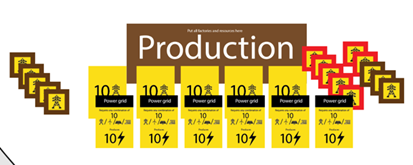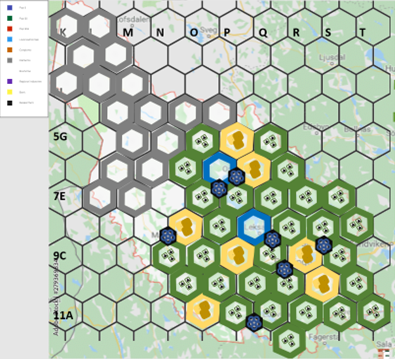The team and I were excited to be invited to play Switching the Current in Borlänge, and as part of the preparations for this event we localised the game to the county of Dalarna, which lies far north of Östergötland, the setting of the first version of the game (as was the Climate Change Megagame). The major differences between the two counties are the population size (500,000 in Östergötland compared to 300,000 in Dalarna), natural resources (Östergötland has vast areas of farmland and some forests, whereas Dalarna is mostly made up of dense forests), and – last but not least – energy production (Östergötland has very little, whereas Dalarna produce 3100 GWh worth of hydropower annually). When beginning the redesign based on an energy system chart from 2020 (Fig. 1), I asked my if it would be possible to use the same setup in terms of tables and other game mechanics for Dalarna as the game had been built with Östergötland in mind.




On the whole, using a different energy system chart did not present too much of a problem, after the matter of whether to create a separate company for the production of hydro- and wind power was settled – I placed all power production with Conglomo, making the company considerably less dependent on the market, but also subject to paying for maintaining the dams and wind power plants. A minor snag was that the district heating company Elementa, which was a major player in the Östergötland version, barely scraped by in the Dalarna version. Despite this, the fairly easy translation process gave hope that it would be possible – and even interesting – to do the same for other areas of Sweden (and abroad) in order to both make it easier for players to recognise problems/potentials in their home area and identify differences and similarities between games set in different areas.

The relative ease with which the game could be localised to a different geographic area pointed to aspects of the game that has yet not seen much development: social aspects, land use, and area-specific conflicts. As for the first aspect, the game does not take into consideration that the populations of the two regions are likely to be very different in terms of outlook on life, history, and social stratification. Instead, it is assumed that the population of Dalarna is for the most part going to react similarly to situations such as power shortages, social injustices, etc. I unwittingly performed an experiment as regards this when I set the Quality of Life to 10 (half of the other populations) and in 15 years’ time caused social upheaval that resulted in vandalism of the houses of the richest part of the population and the rise of organised crime among the low-income population (Fig. 5).

As for land use, and more specifically forestry, one would possibly have expected it to be more prominent in a game set in a densely forested area. This didn’t play into the game at all, which was surprising but also problematic, seeing as many of the strategies proposed involve using (or leaving well alone) the forests of areas such as Dalarna. This will have to be addressed in the next iteration of the game, possibly in connection with the development of the map and rules connected to it.
As for the last aspect, area-specific conflicts, it may suffice to say that aside from the Regional Industries table seeing development to reflect the fact that Dalarna is home to heavy industry such as steel plants and pulp mills, we depended entirely on the players to act out all such conflicts using the game mechanics as scaffolding. I could not see much of this, which may mean that unless my colleagues picked up on this, we need to do more research before localising the game and – at the very least – tailor the information in the role descriptions of some of the players to ensure they remember/are aware of some major issues that the area is facing before they being playing the game.
It was very interesting and indeed welcome to set the game in a new area – this was proposed for the Climate Change Megagame in the past (setting the game in Norfolk, England), but was never realised as I was unable to see where to start, and now there’s a possibility I may be able to take on the task as I see more clearly what may be needed. More importantly, I’m much better prepared for setting the game in another location in Sweden, which is very likely to be called for already in 2023.
My next blog post will discuss the role of the scenario in the game and the ability of players to influence events on a global scale – and their own situation, as in the case with the low-income population players during the Borlänge playtest.
